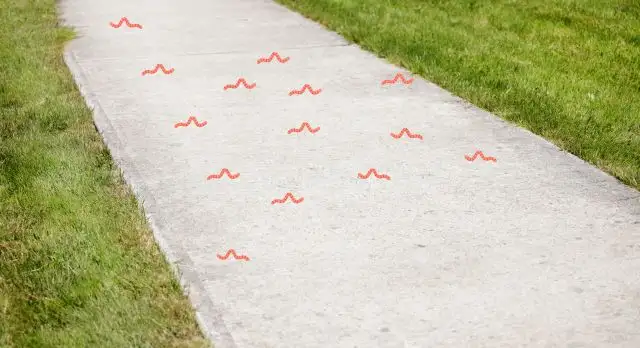Why Are There So Many Dead Worms on the Sidewalk? Mystery Unveiled
Walking down the sidewalk on a rainy day, you may have noticed a puzzling sight—numerous dead worms scattered along the pavement. It raises the question: “Why are there so many dead worms on the sidewalk?” In this article, we will delve into the factors behind this phenomenon, exploring the unique challenges that worms face when venturing onto the sidewalk. Let’s unravel the mystery and shed light on the unfortunate fate of these fascinating creatures.

Why Are Worms Found Dead on the Sidewalk?
Worms are typically found underground, thriving in the moist and dark environment of the soil. However, several factors contribute to their untimely demise on the sidewalk. Let’s explore the key reasons:
Surface Exposure: Worms on the sidewalk are exposed to unfavorable conditions they aren’t adapted to handle. Sunlight, heat, and dryness can quickly dehydrate their delicate bodies.
Escape from Waterlogged Soil: During heavy rainfall, worms may venture onto the sidewalk to escape waterlogged soil. However, they face a challenging transition, as the sidewalk’s surface cannot provide the moisture and protection they need.
Lack of Orientation: Worms navigate through the soil using various cues, such as gravity and moisture gradients. On the sidewalk, they lose their sense of direction, leading to disorientation and vulnerability.
Factors Contributing to Worm Mortality on the Sidewalk
Understanding the specific factors that increase worm mortality on the sidewalk can shed light on the severity of the issue. Here are some crucial aspects to consider:
- Sunlight and Heat Exposure: Worms lack a protective outer layer, making them sensitive to sunlight and heat. Direct exposure can cause dehydration and damage their skin, leading to death.
- Desiccation (Drying Out): The sidewalk’s dry surface absorbs moisture from worms, rapidly dehydrating them. Without the moist environment they depend on, their bodies dry out, impairing vital functions.
- Predation: Predators, such as birds or insects, are more likely to spot worms on the sidewalk than when they are underground. This increases the risk of becoming prey, further contributing to their mortality rate.
Steps to Help Worms Survive Sidewalk Encounters
While we cannot entirely eliminate the challenges worms face on the sidewalk, there are steps we can take to mitigate their risk and increase their chances of survival. Consider the following:
- Provide Moisture: If you encounter worms on the sidewalk, gently move them back to a nearby moist area, such as a garden bed or lawn. This allows them to regain the necessary moisture levels and escape the drying effects of the pavement.
- Create Worm-Friendly Spaces: Design your outdoor space with worm-friendly elements. Implement shaded areas, mulch beds, and moist soil patches to encourage worms to stay within their preferred habitats.
- Raise Awareness: Educate others about the challenges worms face on the sidewalk. Encourage responsible actions, such as avoiding unnecessary harm and helping worms reach safer environments.
Conclusion
The sight of dead worms on the sidewalk may be disheartening, but understanding the factors behind their mortality can lead to positive change. Sunlight exposure, dehydration, and lack of orientation contribute to the unfortunate fate of these creatures. By taking small steps to assist worms and raising awareness, we can minimize their casualties and appreciate their vital role in maintaining soil health.
Remember, every action counts. Whether it’s gently relocating worms or creating worm-friendly spaces, we can contribute to their survival. Let’s embrace our role as caretakers of the natural world and ensure that worms and other creatures thrive,even in urban environments. By working together, we can make a difference and preserve the delicate balance of nature.
Key Takeaway
The presence of dead worms on the sidewalk is a result of various factors, including exposure to sunlight, heat, and dehydration. Worms on the pavement are outside their natural habitat, lacking the necessary moisture and protection to survive. By understanding these challenges and taking proactive measures to assist worms, we can help increase their chances of survival. Whether it’s providing moisture, creating worm-friendly spaces, or raising awareness, our efforts can make a positive impact on these fascinating creatures. Let’s show compassion and respect for the smallest inhabitants of our ecosystems, fostering a harmonious coexistence between humans and worms.
Why do worms crawl on the sidewalk and die?
Worms crawl on the sidewalk and often die because they accidentally end up there while trying to escape waterlogged soil. When the soil becomes too wet, worms move to drier areas, and the sidewalk may seem like a safe option. However, the sidewalk is not suitable for their survival. The sunlight, heat, and dryness on the pavement quickly dehydrate the worms, causing them to die.
Why are there dead worms on the sidewalk?
There are dead worms on the sidewalk because worms are adapted to live in the soil, where it’s moist and dark. When worms mistakenly end up on the sidewalk, they face harsh conditions that they cannot survive. The sunlight and heat on the pavement dry out their bodies, leading to dehydration and death. It’s unfortunate, but the sidewalk is not a suitable environment for worms, and many of them perish as a result.
